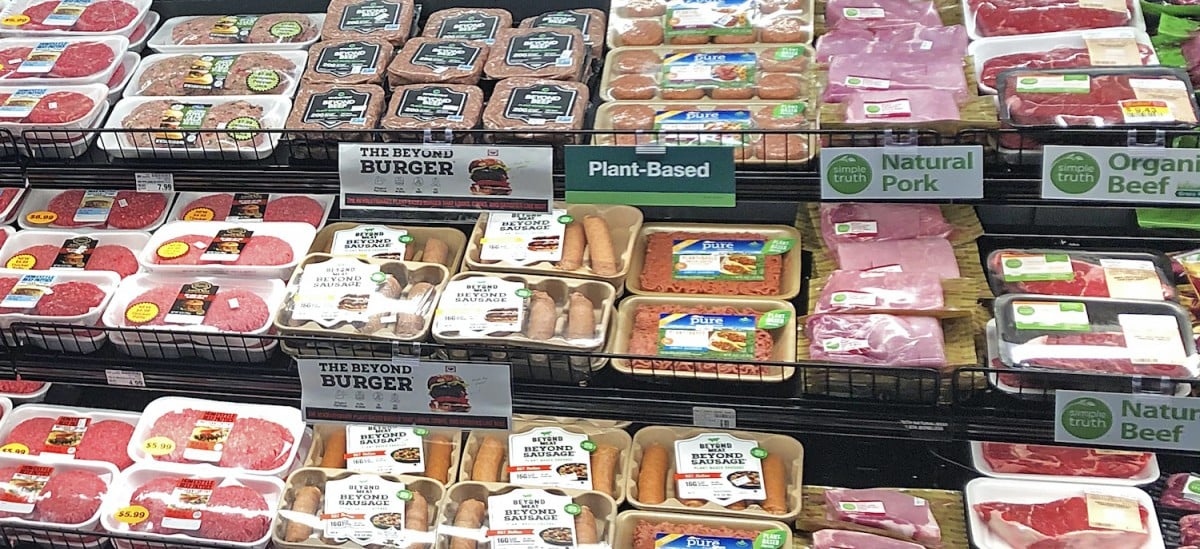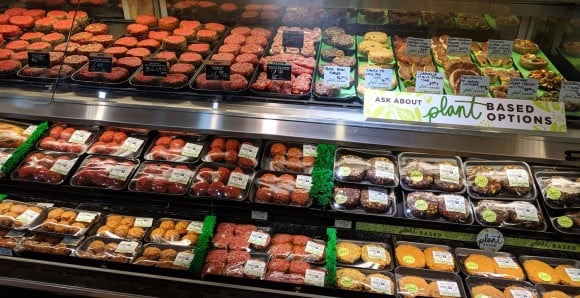Meat-aisle merchandising catapults plant-based meat sales

Gone are the days when plant-based meat was confined to the produce aisle. New evidence from The Kroger Co. and Heinen’s bolsters the case for shelving plant-based meat products in the meat aisle. Kroger’s recent merchandising test and Heinen’s sales performance show significant gains in plant-based sales when placed in the meat section, and offer key strategies for retailers to adopt in their own stores.
Kroger study demonstrates sales increase
The Kroger Co., in collaboration with the Plant Based Foods Association, recently released results from a study on merchandising plant-based meat in the meat department. The study, which ran from December through February at 60 test stores, placed plant-based meats in a dedicated 3-foot set within Kroger’s meat department. Across test stores, plant-based meat sales increased an average of 23 percent compared to the control group.
“This test provides one more proof point that plant-based meats have moved from niche to mainstream. Kroger continues to experience double-digit growth in the plant-based category, and this test demonstrates the viability of shifting product placements to reach even more customers.”
—Sean Brislin, Kroger Merchandising Director
Measuring the shift toward plant-based integration
Shelving plant-based meat in the meat aisle is part of an integrated-segregated merchandising strategy that meets the needs of the widest range of consumers, placing plant-based products next to conventional items in a separate plant-based set. Retailers successfully implemented this merchandising strategy with the natural and organic category. By shelving natural and organic products alongside their conventional counterparts, retailers boosted these products’ sales and normalized integrated-segregated merchandising. This same logic—and the resulting sales growth—drives retailers to deploy an integrated-segregated strategy for plant-based categories.
For categories with a small selection of plant-based products, such as plant-based eggs, a fully integrated strategy, with plant-based products and conventional products shelved together, may be a good option. A segregated strategy is much less effective for established categories as it isolates plant-based products in a separate stand-alone set. This limits exposure to the majority of consumers as plant-based options are not presented where consumers normally shop. It’s all about empowering the consumer to understand the options and make a choice.

Data demonstrates several reasons retailers should adopt an integrated-segregated strategy:
- Increase sales. This shelving approach allows consumers to shop their go-to area and compare between plant-based and animal-based products. This drives new trials, leads to opportunities to trade up, and ultimately increases revenue for retailers.
- Make the customer happy. 76 percent of all consumers prefer to shop for plant-based meat in the meat or frozen section, compared with 24 percent who prefer the produce area, according to the Food Industry Association.
- Keep up with the competition. In GFI’s inaugural Retail Report, we found that 65 percent of the top 15 retailers merchandise at least one refrigerated plant-based meat product in the meat aisle.
Heinen’s successfully integrates across categories
As one of the first chains to integrate plant-based categories with their conventional counterparts, Heinen’s Grocery Store, with 23 locations in Northeast Ohio and the Greater Chicago area, is also proving out integrated-segregated merchandising.
Chris Foltz, Heinen’s Chief Innovation Officer, said the retailer’s decision to integrate plant-based foods was driven by a desire to stay relevant, fulfill shopper needs, and appeal to the large consumer base looking for plant-based options. GFI worked with Heinen’s to explore ways to elevate plant-based and be a more health-forward, innovative partner to customers. As a result, Heinen’s adopted an integrated-segregated model for plant-based categories across the store, including in the meat aisle.

“Not only did we need those solutions, but we needed them across all categories and not just in one section of the store,” said Foltz. With GFI’s help, Heinen’s focused on categories with large opportunities—meat, dairy, frozen, and deli—and collaborated with their wellness team to build out two full doors in the meat department. They also hosted demos such as product tastings, cooking demonstrations, and cart makeovers two times per week, with educated associates and nutrition experts to engage customers.

Heinen’s finds that 50 percent more customers shop the meat section than the deli section where plant-based meat products were previously shelved—meaning the move swelled consumer exposure. Similarly, Foltz said shifting plant-based dairy products to the dairy aisle doubled the consumer exposure to plant-based dairy. And these gains played out in sales as well—after incorporating the merchandising changes across the store, Heinen’s saw a 43 percent year-on-year increase in dollar sales of plant-based meat in the year ending March 25, 2020, and a 106 percent increase compared to the prior two years.
Envisioning the protein department of the future
These merchandising changes are all part of a big-picture shift. The meat department as we know it is transforming into a protein department—serving up conventional protein alongside plant-based protein (and someday soon, cultivated protein) from the butcher counter to the packaged meat section.
This protein department of the future is a world of opportunity. The plant-based meat category today is reminiscent of the plant-based milk category in its early stages of rapid growth, when it was first moved from the center-of-store to the refrigerated dairy case. Plant-based milk now accounts for 14 percent of all dollar sales for retail milk and has 41 percent household penetration.
Plant-based meat could reach market share parity with plant-based milk at a 13-point gain of total retail meat market share. According to Nielsen, the total retail meat category in the United States is valued at $95 billion, so the opportunity to gain 13 share points would be worth more than $12 billion.

Plant-based meat is a $939 million category, with dollar sales growth of 18.4 percent in 2019. And Covid-19 has put a magnifying glass on American consumers’ desire for meat made from plants. IRI retail sales data from The Analogue Dish shows that, from March 1 through June 7, 2020, fresh plant-based meat—increasingly sold in the meat aisle—has performed particularly well, with sales growth as high as 454 percent during peak pantry stocking compared to the same week in 2019. This is significantly more than fresh animal meat’s 100 percent growth over the same period, demonstrating that plant-based is attracting a broader consumer base that is anything but niche.
Plant-based food is here to stay, and it’s growing rapidly. For retailers to capitalize on this opportunity, they should ensure plant-based meat is merchandised where consumers are already shopping for center-of-plate protein—in the meat aisle.
Want to learn more about plant-based retail trends and strategies? Check out GFI’s Good Food Retail Report to see the overall ratings for the top 15 U.S. retailers, as well as product assortment, merchandising, and marketing insights.

